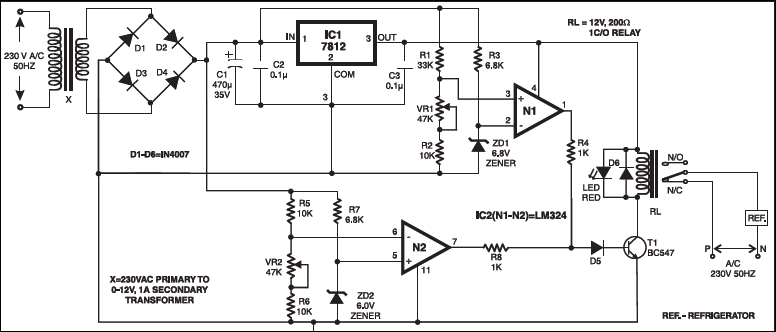 Presented here is an under/over-voltage protection circuit that protects refrigerators as well as other appliances from under & over-voltage. Operational amplifier IC LM324 (IC2) is used here as a comparator. IC LM324 consists of four operational amplifiers, of which only two operational amplifiers (N1 and N2) are used in the circuit.
Presented here is an under/over-voltage protection circuit that protects refrigerators as well as other appliances from under & over-voltage. Operational amplifier IC LM324 (IC2) is used here as a comparator. IC LM324 consists of four operational amplifiers, of which only two operational amplifiers (N1 and N2) are used in the circuit.

Circuit Operation
The unregulated power supply is connected to the series combination of resistors R1 and R2 and potmeter VR1. The same supply is also connected to a 6.8V zener diode (ZD1) through resistor R3. Preset VR1 is adjusted such that for the normal supply of 180V to 240V, the voltage at the non-inverting terminal (pin 3) of operational amplifier N1 is less than 6.8V. Hence the output of the operational amplifier is zero and transistor T1 remains off. The relay, which is connected to the collector of transistor T1, also remains de energized. As the AC supply to the electrical appliances is given through the normally closed (N/C) terminal of the relay, the supply is not disconnected during normal operation.
Over-voltage protection
When the AC voltage increases beyond 240V, the voltage at the non-inverting terminal (pin 3) of operational amplifier N1 increases. The voltage at the inverting terminal is still 6.8V because of the zener diode. Thus now if the voltage at pin 3 of the operational amplifier is higher than 6.8V, the output of the operational amplifier goes high to drive transistor T1 and hence energize relay RL. Consequently, the AC supply is disconnected and electrical appliances turn off. Thus the appliances are protected against over-voltage. Thus the appliances are protected against over-voltage.
Under-voltage protection
Now let’s consider the under-voltage condition. When the line voltage is below 180 V, the voltage at the inverting terminal (pin 6) of operational amplifier N2 is less than the voltage at the non-inverting terminal (6 V). Thus the output of operational amplifier N2 goes high and it energizes the relay through transistor T1. The AC supply is disconnected and electrical appliances turn off. Thus the appliances are protected against under-voltage. IC1 is wired for a regulated 12 V supply.
Thus the relay energizes in two conditions: first, if the voltage at pin 3 of IC2 is above 6.8V, and second, if the voltage at pin 6 of IC2 is below 6V. Over-voltage and under-voltage levels can be adjusted using presets VR1 and VR2, respectively.
Feel interested? Check out some other interesting projects in the circuits section.







What is the set value for the potentiometer for 180v and 240v range.?
Which potentiometer is for undervoltage and over voltage
What if Over voltage burns out the transformer X. The whole circuit will be powered off and Relay contact will enable power to respective device. It will ultimately burn out.???
Excelente apreciación, debería modificarse el sistema para trabajar con un relee normalmente abierto de tal forma que si falla el dispositivo el equipo no se energizará sin protección. Saludos desde Venezuela.
plzz tell me applications and complete explanation for the project not circuit diagram connections
I make this ckt But when i apply voltage under 180 or beyond the 240 voltage the relay doesn’t cut the Supply . Please help me and reply me soon
Hi.you are right. The error is at the comparator output.
This can be rectified by using AND gate
exellent
This circuit works or not?
what is the role of R4 and R8 resistor in this circuit ??/
They are used as base resistances for transistor T1.
Can I take 5KV load from this circuit ?